When reading about dinosaurs or visiting a museum you may have wondered: how do scientists determine the age of fossils? Are they millions of years old?
How do scientists know that, for example, Tyrannosaurus rex lived about 66 million years ago? Are these estimates verifiable?
So, how do scientists determine the age of a fossil? Scientists use two general techniques to date fossils: stratigraphy and radiometric dating.
We must first examine these two techniques to understand how scientists find a fossil’s age. Let’s get to it.
Steno’s Laws of Stratigraphy
First, we’ll start with stratigraphy. Stratigraphy refers to the art of determining the relative ages of sedimentary rocks. In other words, it tells us which stones are the oldest, which are the youngest, and which fall somewhere in the middle.
Nearly all fossils are found in sedimentary rocks. If you’re curious, we have a full article on why fossils are found in sedimentary rocks.
Stratigraphy was discovered by a Danish geologist, Nicholaus Steno, in 1669 when he published a seminal work on the subject. His treatise proposed several principles for understanding sedimentary rocks, which came to be known as Steno’s Laws of Stratigraphy. The laws are as follows:
- The Law of Superposition
- The Law of Original Horizontality
- The Law of Cross-Cutting Relationships
- The Law of Lateral Continuity
The first law, the Law of Superposition, states that sedimentary rocks on the bottom are the oldest and that sedimentary rocks on the top are the youngest. Consider the following photograph of the Grand Canyon:
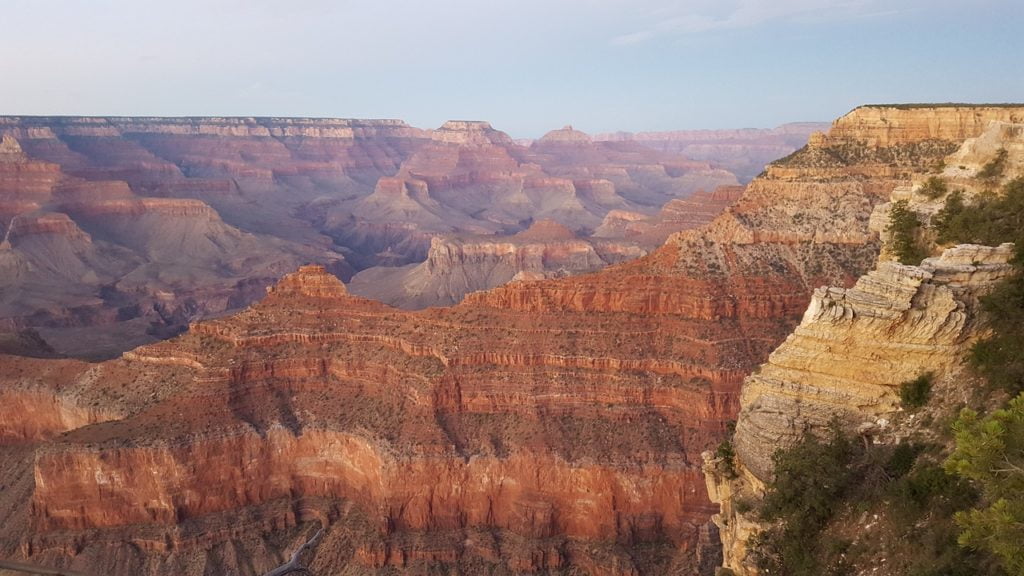
The layer of rock indicated by the red arrow is older than the layer indicated by the orange arrow; the layer indicated by the orange arrow is older than the layer indicated by the yellow arrow. Scientists can draw these conclusions due to the Law of Superposition.
The second law, the Law of Original Horizontality, states that sedimentary rocks are always deposited in horizontal, flat bands. They may not, however, remain flat, because plate tectonics can bend and fold the earth’s crust.
This will also bend sedimentary rocks. Examine the photograph, below, of a rock outcrop in Morocco:
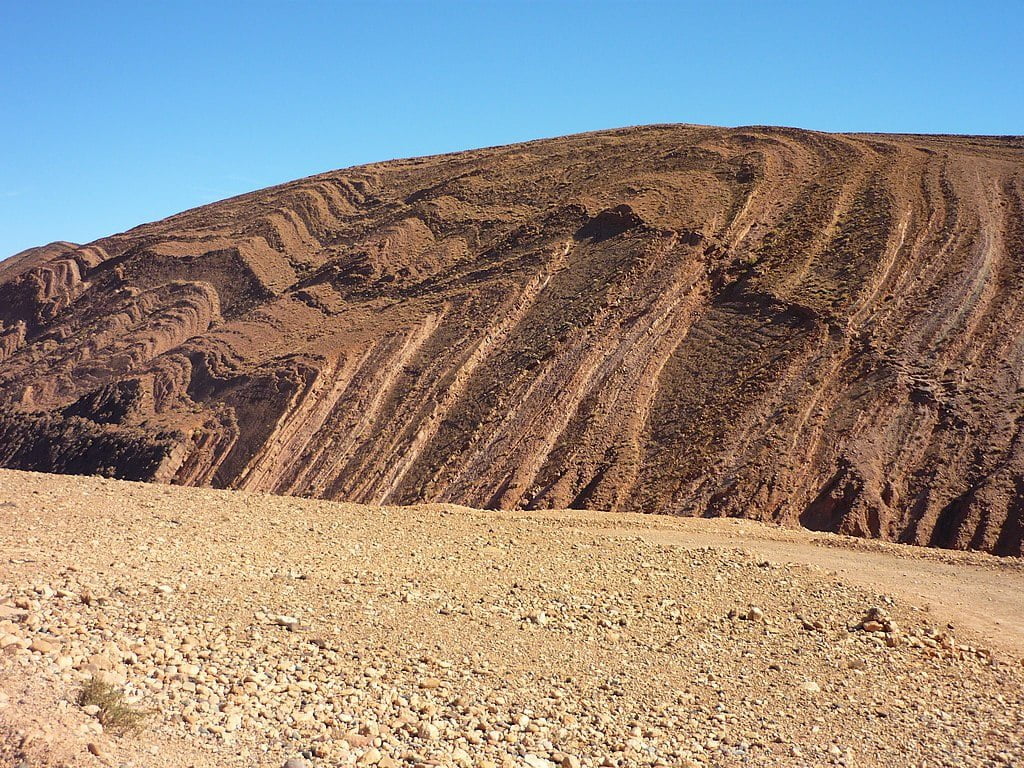
Notice how different the sedimentary rock layers in the above photograph appear when compared to the rock layers in the Grand Canyon. Even so, long ago, these rocks once looked like the flat layers in the Grand Canyon, but plate tectonics have since crumpled them. Scientists can make this conclusion with the Law of Original Horizontality.
The third law, the Law of Cross-Cutting Relationships, states that when a layer of rock has an intrusion in it, the intrusion is younger than the rocks into which it has extended itself. Can you see the intrusion in the photograph below?
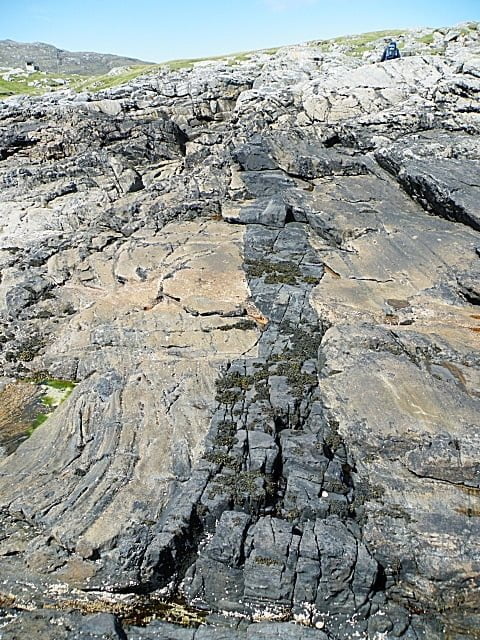
This rock outcrop has a clear intrusion, a band of darker grey rock, running through the center of it. Because of the Law of Cross-Cutting Relationships, we can conclude that the intrusion is younger than the surrounding rock.
The last law, The Law of Lateral Continuity, states that sedimentary rocks are deposited in a continuous, flat plane until something physically stops their deposition and/or erodes them after deposition. This law enables scientists to correlate sedimentary rocks by following their planes. To illustrate this principle, we will again return to the Grand Canyon:
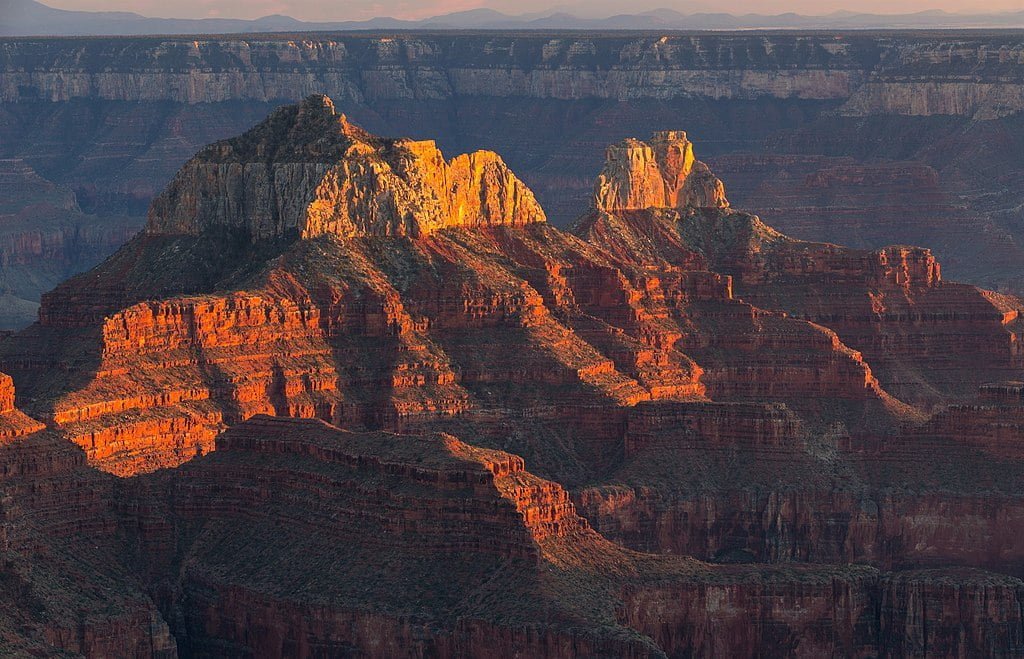
Notice how the mountain in the left foreground is divided into three distinct bands: a darker, more mottled layer at the top, a yellow-brown layer in the middle, and a deep red layer underneath that. Can you see how this pattern is reflected in the smaller peak to the right, even though they’re not connected?
Now, look at the background of the canyon. Do you see a similar pattern in the rock there? Scientists use the Law of Lateral Continuity to connect all of those rock layers even though they’re not physically connected.
These four laws are illustrated in the image below. Can you relate each image to its corresponding law?
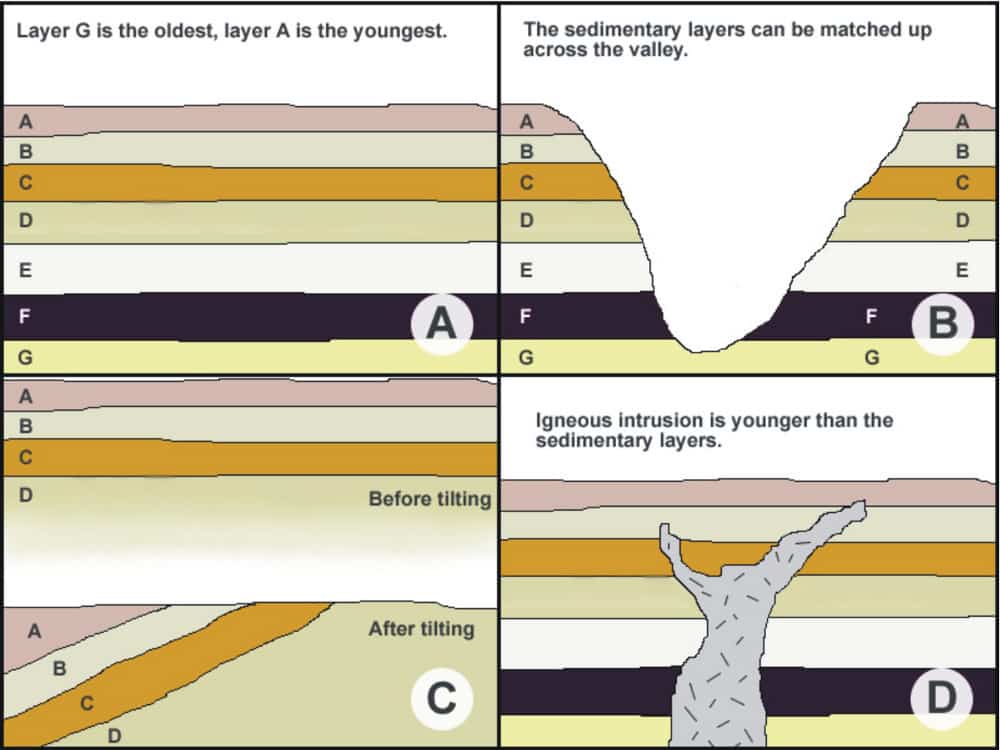
Answers:
- Law of Superposition
- Law of Lateral Continuity
- Law of Original Horizontality
- Law of Cross-Cutting Relationships
Now that you’re familiar with the Laws of Stratigraphy, can you determine the relative ages of the rock units in the image below?
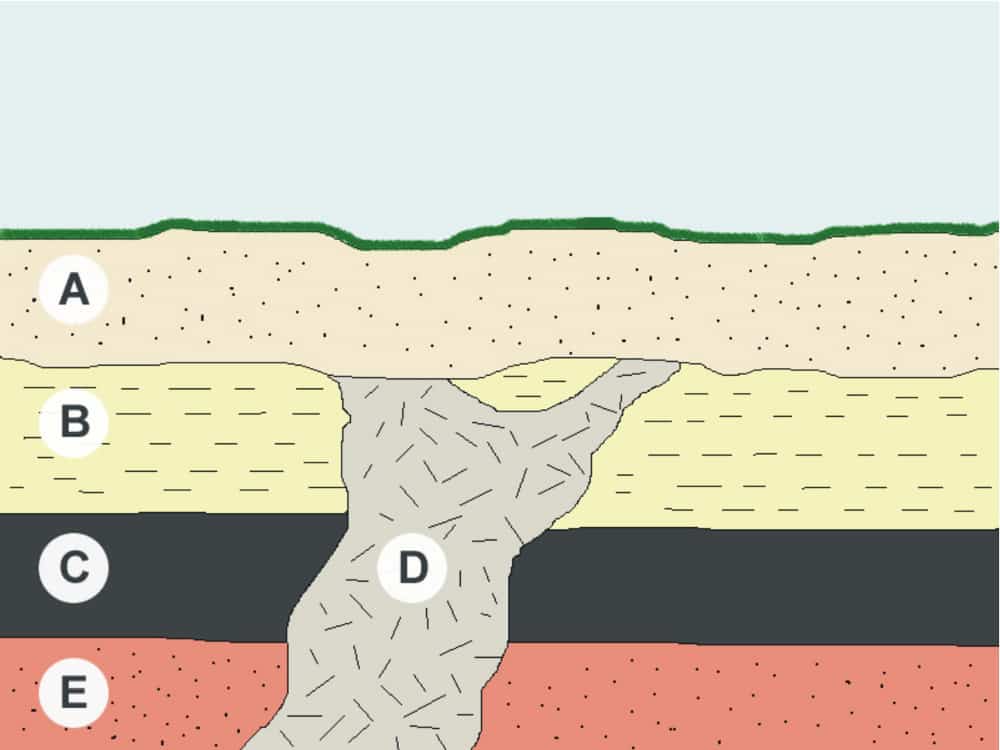
Answers:
From oldest to youngest: E, C, B, D, A.
If you’d like to learn more about Steno’s Laws, you might find this ThoughtCo article interesting.
Scientists use Steno’s Laws of Stratigraphy to construct a global framework for the relative ages of rocks. With this framework, scientists can tell which rocks are the oldest, which are the youngest, and which fall somewhere in the middle.
This framework does not tell scientists, however, the exact ages of the rocks. In order to do that, they use a different technique: radiometric dating.
Radiometric Dating
Radiometric dating is a method of finding the absolute age of rocks by looking at radioactive decay within igneous rocks. Contrast this with stratigraphy, which only provides the relative, not absolute, ages.
Radiometric dating works by measuring the concentrations of daughter isotopes in a rock that was formed exclusively from the radioactive decay of a parent isotope. If the concentrations of both the parent isotope and daughter isotopes within a single rock are known, then the absolute age of the rock can be calculated.
Do note that radiometric dating is complex enough that it would, at the very least, need its own article. As such, I have limited its discussion to a very brief summary. You can check out this article on geochronology by Britannica to learn more about radiometric dating and similar methods.
The Process of Dating Fossils
Once the absolute ages of certain rocks can be calculated via radiometric dating, the ages of these rocks can be applied to the relative stratigraphic ages obtained from Steno’s Laws.
From there, scientists estimate the absolute ages of sedimentary rocks that they couldn’t otherwise date with radiometric dating. Then, once scientists have figured out how old sedimentary rocks are, they can conclude the age of fossils. This is because the fossils are the same age as the rocks that contain them.
Even though scientists can accurately estimate the age of rocks and fossils, there’s still a bit of wiggle room in their estimates.
As an example, the Hell Creek Formation of the American West, which contains many famous dinosaur fossils including Tyrannosaurus rex, was deposited roughly 67 to 66 million years ago. Its exact age, however, remains uncertain.
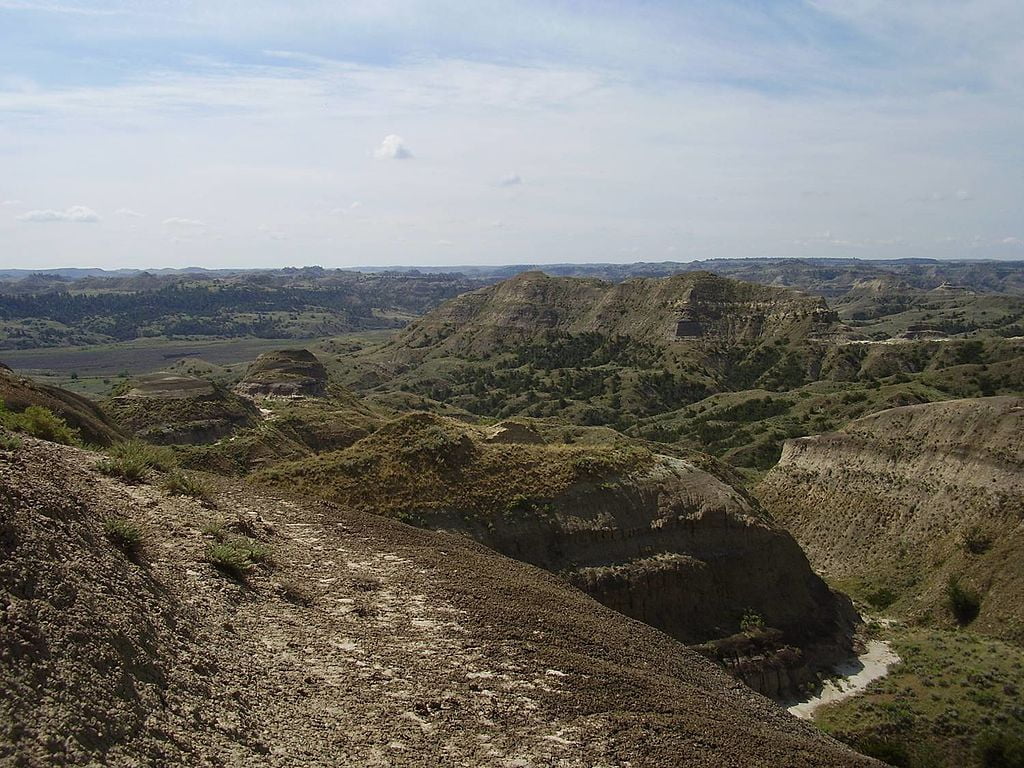
For example, scientists have limited its youngest rocks to 66 ± 0.07 million years old, a variation of 0.1%. As scientists refine their estimates of the age of this and other formations, the dates may shift slightly. Thus, most people are content to round off the age estimates and simply say “66 million years old,” for example.
So it’s clear that much information can be garnered from dating rocks accurately. Paleontologists often rely on index fossils to determine the age range of the observed formations.
For more on index fossils and the geologic time scale, we have dedicated articles to those topics.
How Do Scientists Determine the Age of Fossils?
To learn the age of fossils, scientists use a variety of methods. First, they use Steno’s Laws of Stratigraphy to establish the relative ages of rocks. Then they use radiometric dating to find the absolute ages of rocks. From there, they can learn both the absolute ages of rocks and any fossils that they may contain.
The science behind the age of the Earth, stratigraphy, correlation, and radiometric dating is quite complex, has a rich history, and involves much more than is discussed in this article. As such, this article is intended as a sound introduction to some of the basics.
Hopefully, you learned something from this article. If so, please share it with your friends. If you have additional questions or want to add something to the topic, leave us a comment to let us know.


Hi Matthew great article. Do you know where I could find more info on the first fossils/nearby rocks to be radio dated? Like, they didn’t really know the earth’s age confidentally until after the 1930s, so I wonder how old did they think the dinosaur fossils were?
Great question, Pat!
Here is an article on determining the age of Earth throughout time. In short, it was a mess until as recently as the late 1920s, as you mentioned.
How Did Scientists Calculate the Age of Earth? [National Geographic]
Prior to radiometric dating, stratigraphy was used. Scientists began to understand that fossils in deeper rocks were older. The biggest question was: how much older?
Stratigraphy [Wikipedia]
The 1800s were a profound time in science. The naming of dinosaurs and Darwin’s Origin of Species propelled the idea of truly ancient time. So, throughout the 19th century the estimate of Earth’s age and subsequently the earliest life forms were estimated in millions not billions of years.
In 1905, physicist John William Strutt dated a rock to 2 billion years using radiometric dating. The accuracy of this was a bit off, but it was a proof of concept.
Development of Radioactive Dating [Britannica]
Of course, there was always a great deal of contention within the scientific community when the consensus was challenged.